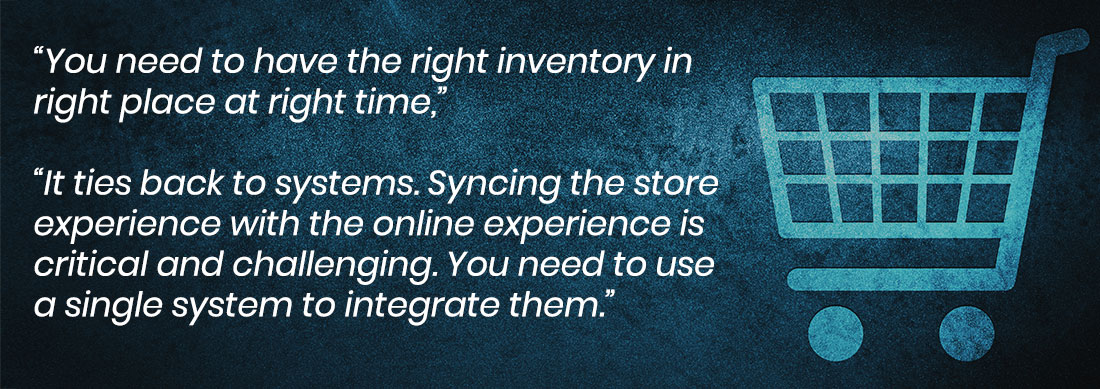How are Omnichannel Retailers managing inventory in the face of the global pandemic, supply chain bottle necks and labor shortages? You might be shocked at what you learn.

Inventory Management is the cornerstone of a successful omnichannel retail strategy. Consumers expect brands to provide a seamless shopping experience whether they are ordering from an e-commerce website, mobile device, a physical store, or through an Instagram partnership. To meet this multi-channel demand, retailers must provide inventory wherever their customers are. But in today’s environment, many retailers struggle to effectively manage inventory across their sales channels, with 51 percent of retailers reporting that between 2 percent and 10 percent (even higher today) of orders could not be fulfilled because of inventory inaccuracy. With the recent supply chain disruptions from the pandemic, bottle necks and labor shortages, retailer out-of-stocks can be 100% on many categories and items. While leading a recent search engagement, Carpe Diem Partners had the opportunity to speak with dozens of supply chain leaders over the last three months regarding how omnichannel has changed inventory planning for their companies. Supply chain leaders represented some of the largest and most progressive-thinking retailers in the world. Speaking with these leaders, it became clear that the complexity of omnichannel and changing consumer behaviors in the wake of the COVID-19 pandemic require new ways of approaching the supply chain and inventory planning.

Inventory visibility and forecast accuracy are critical
The pandemic highlighted for retailers the importance of inventory visibility and demand forecast accuracy in their omnichannel strategies. With in-store restrictions and social distancing guidelines pushing more people to shop online, it’s essential for omnichannel retailers to understand where inventory is and to track changes in real-time. That’s exceedingly difficult with traditional approaches that segment by inventory channels, with each managed by a dedicated system. The visibility gaps this creates are responsible for virtually every problem in the order fulfillment process, including out-of-stock items, delayed delivery, overstocking, and preventable returns.
For retailers, the cost of these issues is high. Studies have found that 27 percent of consumers would be very likely to leave and visit another retailer’s store if a product is out of stock, while 21 percent would buy online from a different retailer and another 21 percent would simply hold off purchasing the product.

Digitally native management solutions that provide a consolidated real-time view across all retail, web, and wholesale channels are essential for a successful omnichannel retail experience, leaders agree. This enables retailers to create a single stock pool, even if inventory is physically housed in multiple locations, and allocate inventory toward the channels where it is in the highest demand. A customer wanting to purchase an item online, for example, won’t be told it’s out of stock if there is plenty of inventory at a retail store. Consolidated inventory visibility also enables retailers to reconcile the inventory on hand against projected demands, ensuring they replenish product effectively. Using RFID technology at the product level is generating strong results.
“For omnichannel to be successful, you need to place inventory where the customer wants it and it’s most economical to ship, such as ship from store,” said one leader. “The cost of getting that product to the customer is very important. Real-time inventory visibility lets you have it in the place that’s most economical.”

Start with the user experience
As the pandemic forced people to embrace e-commerce, shoppers have naturally become more comfortable engaging multiple channels as it suits them. They now expect multiple options for purchasing and receiving an item including home delivery, buying online and picking up at the store, and shopping by appointment. But shoppers don’t care where a product is coming from, they just want a consistent, painless experience across all a brand’s channels regardless of the challenges the pandemic poses for the brand’s omni-retail systems. The onus is on retailers to adjust their inventory strategies to ensure they’re flexible enough to meet their customers’ expectations.
The supply chain leaders we spoke with emphasized the need to focus on customers’ needs and preferences and let those guide inventory strategy. “We start our inventory planning with the customer experience,” one leader said. “You need to understand what your customer wants and needs and then work backwards to ensure your systems can meet them.”
For most omnichannel retailers, that means developing separate strategies for store and online platforms. “The sales curve is very different for buying in-store, buying online, and buying online and picking up at a store,” said one leader. “They have different inventory paths and they all need to be strong.”
Determining customer journeys for different segments can help retailers identify which of their channels should be modified to improve convenience for the customer and optimize order fulfillment. Retailers can also gather actionable feedback from customers through email, social media, or mobile app surveys to further help shape an omnichannel experience that allows customers to shop the way they choose during the pandemic and beyond. RFID at the product level allows stores to have greater confidence in inventory numbers when servicing customers.


These market insights from Carpe Diem Global Partners are gathered from the firm’s extensive client work leading Board, CEO, CXO, and CHRO executive search engagements for public and private multinational companies. For deeper, custom insights, contact Brad Daggett at bdaggett@carpediempartners.com.

